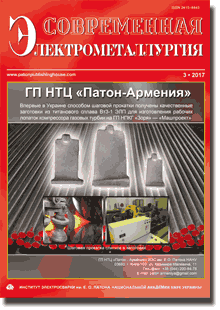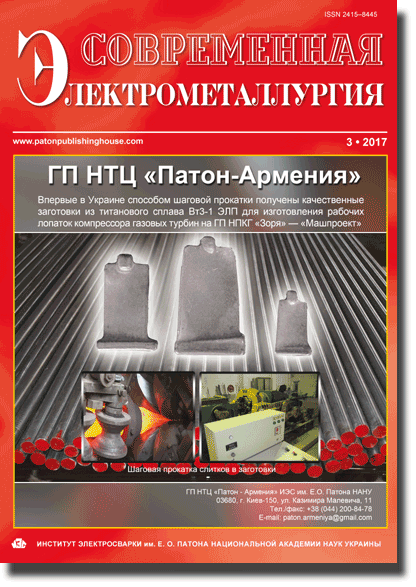| 2017 №03 (01) |
DOI of Article 10.15407/sem2017.03.02 |
2017 №03 (03) |

Electrometallurgy Today (Sovremennaya Elektrometallurgiya), 2017, #3, 9-14 pages
Physical modeling of electrode metal drop transfer in ESM with superposition of pulsed magnetic fields
I.V. Protokovilov, V.B. Porokhonko
E.O. Paton Electric Welding Institute, NASU. 11 Kazimir Malevich Str., 03680, Kiev, Ukraine. E-mail: office@paton.kiev.ua
Using the physical modeling the peculiarities of process of electrode metal drop transfer were investigated in electroslag remelting with a superposition of a pulsed longitudinal magnetic field on the working zone. The investigations were carried out on optically transparent cold model, filled with an electrolyte on ZnCl2 base, simulating the slag melting, in which the consumable electrode of Wood alloy was melted. It was found, that under the action of a pulsed longitudinal magnetic field the horizontal rotations are formed in a pool, the speed of which depends on the kind and value of current in electrolyte, magnetic field induction and duration of pulses of its action. It is shown that the pool rotation around its axis causes the deformation of its free surface. By using the pulsed magnetic field the pool surface deformation has a periodic nature, thus creating the vibration in a liquid medium It is shown that the superposition of a pulsed longitudinal magnetic field promotes the decrease in electrode metal drop sizes, increase in path and time of their stay in a pool and distribution of dropping places on the molten metal mirror. Moreover, the modulation of melting current at the moment of action of the magnetic field pulses intensifies the magnetic effect on hydrodynamics of the pool and metal drop transfer. Ref. 5, Table 1, Figures 7.
Key words: electroslag remelting; physical modeling; magnetic field; consumable electrode; drop transfer; hydrodynamics
References
- Protokovilov I.V., Porokhonko V.B. (2015) Physical modeling of process of consumable electrode melting in ESR under conditions of external electromagnetic effect. Sovrem. Elektrometall., 1, 8–12 [in Russian]. https://doi.org/10.15407/sem2015.01.01
- Protokovilov, I.V., Porokhonko, V.B. (2015) Physical modeling of ESR process under conditions of action of external electromagnetic fields. In: of 8th Int. Conf. of Junior Scientists and Specialists on Welding and Related Technologies (20–22 May 2015, Kiev, Ukraine), 152 [in Russian].
- Kompan, Ya.Yu., Nazarchuk, A.T., Protokovilov, I.V. (2007) Towards the problem of intensification of electromagnetic action in magnetically-controlled electroslag melting of titanium alloys. Sovremennaya Elektrometallurgiya, 4, 3–7 [in Russian].
- Medovar, B.I., Tsykulenko, A.K., Shevtsov, V.L. et al. (1986) Metallurgy of electroslag process. Ed. by B.E. Paton. Kiev: Naukova Dumka [in Russian].
- Pyatygin, D.A. (2006) Peculiarities of melting and solidification of metal in ESR at direct current with rotation of consumable electrode: Syn. of Thesis for Cand. of Techn. Sci. Degree. Chelyabinsk: YuUrGU, 51 [in Russian].
The cost of subscription/purchase order journals or individual articles
| Journal/Currency | Annual Set | 1 issue printed |
1 issue |
one article |
| TPWJ/USD | 384 $ | 32 $ | 26 $ | 13 $ |
| TPWJ/EUR | 348 € | 29 € | 24 € | 12 € |
| TPWJ/UAH | 7200 UAH | 600 UAH | 600 UAH | 280 UAH |
| AS/UAH | 1800 UAH | 300 UAH | 300 UAH | 150 UAH |
| AS/USD | 192 $ | 32 $ | 26 $ | 13 $ |
| AS/EUR | 180 € | 30 € | 25 € | 12 € |
| SEM/UAH | 1200 UAH | 300 UAH | 300 UAH | 150 UAH |
| SEM/USD | 128 $ | 32 $ | 26 $ | 13 $ |
| SEM/EUR | 120 € | 30 € | 25 € | 12 € |
| TDNK/UAH | 1200 UAH | 300 UAH | 300 UAH | 150 UAH |
| TDNK/USD | 128 $ | 32 $ | 26 $ | 13 $ |
| TDNK/EUR | 120 € | 30 € | 25 € | 15 € |
AS = «Automatic Welding» - 6 issues per year;
TPWJ = «PATON WELDING JOURNAL» - 12 issues per year;
SEM = «Electrometallurgy Today» - 4 issues per year;
TDNK = «Technical Diagnostics and Non-Destructive Testing» - 4 issues per year.





